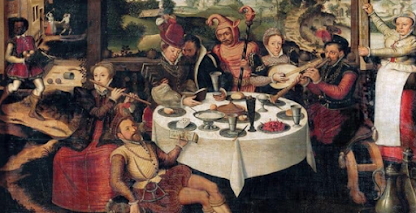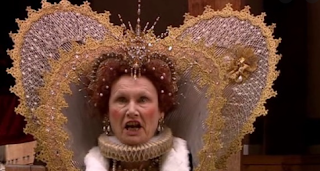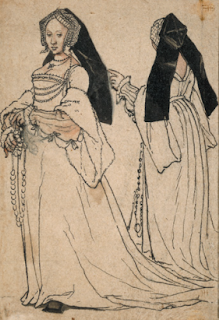Three Occasions when the Tudors Knew How to Party!
The Tudors are well known
for their ability to throw a good party, from feasting and banqueting, to
jousting and pageantry, play and masques. The court attracted not only those
who could sing, dance and act, as a prerequisite for employment, but also a
host of skilled workers to build sets, embroider costumes and prepare the
delicacies that the royal palate demanded. Little excuse was required; feast
days, saints’ days, Christmas and Easter, ambassadors’ visits, royal visits, patronage
and signing treaties were all good reasons for a feast. Henry loved to dress up
and indulge his passions, as Robin Hood, or a mysterious, masked foreigner, but
usually he did not have to find a excuse to party.
October, 1518, London.
To celebrate the Treaty
of Universal Peace with France, and the betrothal of 2-year old Princess Mary
to the dauphin, days of festivities were held in London. It started formally,
at St Paul’s Cathedral, with a mass and peace proclaimed, after which Cardinal
Wolsey hosted a feast at his riverside home, York Place. The Venetian
ambassador wrote that the fare was so sumptuous, that he thought “the like of
which… was never given either by Cleopatra or Caligula,” in a banqueting hall
decorated with huge gold and silver vases. The meal was followed by a mummery,
a silent dance, of twelve male and twelve female maskers, led by the Duke and
Duchess of Suffolk, “in most sumptuous array possible.” Countless dishes of “confections
and other delicacies” were passed around to satisfy their sweet tooth, after
which they “regaled their eyes and hands” when large bowls filled with ducats
and dice were placed on the tables, and the company gambled and danced until
midnight.
June, 1520, France.
In the summer of 1520,
Henry VIII participated in the most expensive event of his reign. After two
weeks spent in France, feasting, drinking and jousting with his rival Francis I,
he was drawing the proceedings to a more sombre close, as Cardinal Wolsey sang Mass
in a temporary chapel, erected in a field. Sackbutts and trumpets played while
the kings took it in turns to kiss a copy of the Gospels. Then, however, their
attention was diverted by an unusual sight in the sky. There appeared a “great
artificial salamander or dragon,” four fathoms long “and full of fire,” which
passed overhead, above the chapel in the direction of the town of Guisnes. It
travelled “as fast as a footman can go” and “as high as a bolt shot from a
crossbow.” Many of those watching were afraid, “thinking it a comet, or some
monster, as they could see nothing to which it was attached.” This sounds like
an early kind of hot air balloon, or elaborate kite, made as a surprise for the
company. The choice of the salamander, which was Francis’ personal device,
point to him as the instigator of a final flourish to the proceedings, or an
attempt to outshine, or outwit the English, although it appeared at a somewhat
inopportune moment. The party dispersed soon afterwards and the English returned
home, with bills to be paid in their hundreds, for the beef, chickens,
strawberries and cream they had consumed. Some foreign visitors even commented on the amount drunk by the English, with their fountains running with wine!
1575, Kenilworth.
In the summer of 1575, Elizabeth I visited her favourite, Robert Dudley, Earl of Leicester, at home at Kenilworth Castle. With their on-off relationship having lasted for over fifteen years, Dudley made a final effort to impress, in the hope of winning the queen’s hand in marriage. Over the course of nineteen days, he entertained her at huge expense, in a huge new tower with glazed windows, in the gardens he redesigned to incorporate a huge lake and all through his beautiful grounds. Elizabeth’s reception at the castle indicates the effort he went to, and the manner of display he created. She arrived around eight in the evening, and was welcomed at the edge of the park by the figure of Sibylla, dressed in white silk, reciting poetry “in the English rhyme and metre.” When she passed through the gates, a porter met her and conducted through to the inner gate, near the base court of the castle. Here, she saw the Lady of the Lake, and two nymphs, seated on a floating island in the middle of a pond, lit by torches, to the sound of music.
From base court onwards, Dudley had constructed a bridge, seventy feet long and twenty feet wide, gravelled, railed and offering views of the entire estate. Seven posts were set along it at intervals, offering gifts to the queen, reputedly from the Gods. First, there were caged birds from Sylvanus, God of Fowl, secondly a silver bowl of fruit from Pomona and thirdly, a bowl with the ears of cereal crops from Ceres. On the fourth pillar were red and white grapes from Bacchus, on the fifth was a tray of fresh grass strewn with fish and sea food from Neptune, the sixth bore weapons from Mars and the seventh was supplied with musical instruments from Phoebus. Dudley’s efforts impressed his queen, but she did not agree to his proposal.
You may also enjoy my book about the The Field of Cloth of Gold, in 1520, a study of the material culture and ceremony of the event:
1520: The Field of the Cloth of Gold eBook: Licence, Amy: Amazon.co.uk: Kindle Store










Comments
Post a Comment